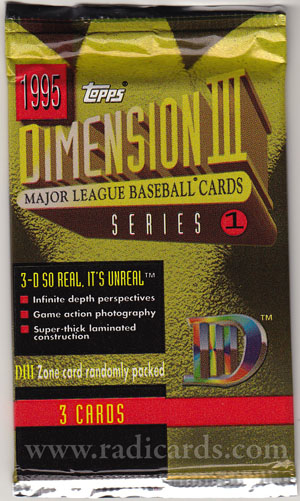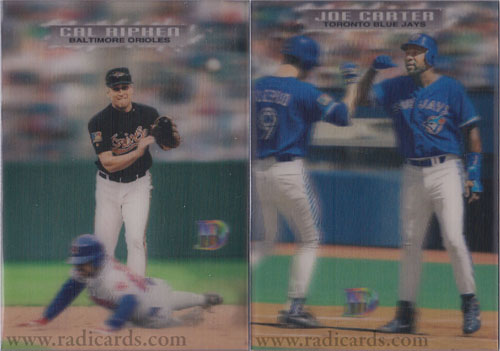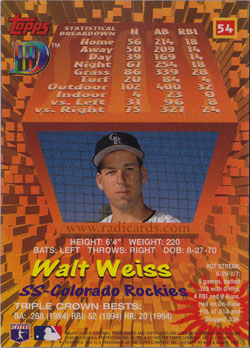
Every now and then, I come across a more peculiar release from a well known company. In this case, it’s 1995 Topps D3 Baseball Series 1. I collected during the time of this products release and I completely missed this issue. It’s weird at best when you’re so involved with something but certain information still seems to find itself masterfully disguised among view. Among the rich real estate that robustly filled the shelves in those shops all those years ago was this little gem. Some products share a healthy and vibrant lifespan growing years within the lives of collections everywhere. Sometimes however, much like pilot programs taken for rides on television’s most prominent networks, there are products that are temporarily tested for degree of market acceptance. Some pilots fly, others crash and even so, some never leave the ground. This is one of those products that I’d like to consider enjoyed a pleasant ride even if for only a very short time. As I walked through with my eyes on the sale rack, I saw this pack sitting there, dusted with the test of time and the lack of love. This pack sat unopened for 17 years and on this day, said goodbye to the sale rack and hello to a more appreciated atmosphere. This was my first experience opening a pack of 1995 Topps D3 and I found the contents to be very forward and necessary for its time. The sportflix-ish technology that goes into this type of product always has my attention. There’s something very pleasant about the way an appearance changes with the manipulation of an angle from a light source. The D3 release showcases a less dramatic manipulation but it’s there. The cards are about twice as thick as your standard baseball card and as such are much sturdier.
The Packaging:
Flashy is a word that comes to mind. The off-yellow, red and black combination brings to mind the memories of long-forgotten composition books used in school. In a time when many packs featured contents in the double-digits, this particular release showcased only 3 cards per pack. I used to associate fewer cards with a higher degree of quality but as I’ve grown, I’ve learned that correlation doesn’t always mean causation. There is something else that I enjoy about the packaging here. It’s that of the tag line, 3D So Real, It’s Unreal. This sort of writing is such a staple of the ’90’s. It reminds me of various slogans found on adverts for a number of early ’90’s products and numerous video games from that time. Entertaining to say the least.
The Contents:
- 3 cards per pack
- Complete set: 59 cards
- D-Zone insert: 1:6 packs

This means that 6 packs will yield only 17 base cards. The 18th card being the D-Zone insert. Further calculations put us at a total of 21 packs to complete this set. That is of course assuming zero probability of doubles. Given the unlikelihood of that scenario, let’s assume a 25-pack total yield requirement to ensure any meaningful probability of completing the full 59-card set. Gone are the days of only one chase program. I can respect this type of simplicity.
The Base Design:

Another classic ’90’s mid-summer feeling. This release is unlike any other Topps product for its time. The sportflix-esque technology happening here always appeals to the interested eye. I am a fan even if for only the remembrance of where I was in my life at the time of this products release. This product features really nice border-less action photos. I like the logo they designed for the D3 product. What you have here is a colorful but simple roman numeral 3 inside a D’ with the first numeral making up the neck of the D. I thought that was clever.

The backs feature beautiful orange tones with a called-for player portrait. The block design happening in the background is a snapshot of a good idea for the time. This sort of thing is very unlikely to be implemented by designers of modern products. Don’t quote me on that, it’s just a hunch. There’s just a lot going on here, some might even say that it looks kinda busy. Notice however, that although the backs don’t feature the same technology as the fronts, the theme still remains the same. Everything on the back has the same 3D feeling. The blocks in the background, the TV box looking design that features the player stats and photo, even the text below the photo all feature the same 3D approach. Much like Cal Ripken’s legendary work ethic, the design is consistent.
Final Thoughts:
With a release unlike the rest, 1995 Topps D3 is a product that takes us back to a time when the hobby possessed much more simplicity. With just 3 cards per pack featuring a sportflix-type technology, D3 reminds us of a marketable design from years ago. However unique and perhaps even considered by some to be kitschy, 1995 Topps D3 Baseball is a stand alone product that can be acknowledged as nostalgic.
To shop for cards from 1995 Topps D3, click here.

 Have you visited our store? Click here.
Have you visited our store? Click here.



This “sportflix-esque technology” sounds very appealing 🙂
Thanks, Anne-Marie! It’s classic 3-D technology. 😉
Wow. I didn’t even know this product existed. Great find and great review. Any reason why you left the pack unopened for so long?
I guess I didn’t make that very clear did I? 😀
I bought the pack the day this article was written. That said, I don’t think a few minutes is very long at all but then again, it all depends on how you define a long period of time. 😉
I bought a box of this back in 1996/1997 (can’t remember the year) at a card show in a mall. Man, I’m really showing my age, huh?
Anyway, I thought this was the coolest concept when I saw the ads in Beckett but never saw these for sale anywhere. And, as you can see from the pack, there were supposed to be 2 series for this set, but after poor sales, Topps discontinued this. At least, that’s what I was told from the dealer that sold me the box.
If I remember correctly, Pinnacle had a similar set called UC3, which was out around the same time as Topps DIII.
All in all, the set wasn’t exactly ground-breaking, but it was pretty cool nonetheless.
Nice! I like ’95 UC3 a little better due to the potential for Artist’s Proof parallels. D3 although quality lacks availability in the insert department.
I collected this entire set hoping that one day it would be of some value…not so much but I still love looking at this set, reminds me of those old Kelloggs sets from the 60s and 70s.
Oh yea, me too. I remember those Kellogg’s sets. Good call.
Somehow, a box of Topps D-III landed in the only convenience store around in the small Iowa town where I grew up (population less than 500). I had no idea what Topps D-III was when I saw it, but I was at my collecting peak in 1995, and thought I’d give it a try. I pulled an Ivan Rodriguez, Rafael Palmeiro, and…I have forgot who was pictured on the third card. The lack of inserts stopped me from going back for more. I bought more UC3 that year. I wouldn’t mind opening a box of D-III now.
I like the D3 concept. That Sportflics technology was always a favorite in the 1990s. This one pack of D3 discussed here is actually the first one I’ve ever opened. It was in a $1 bin at a former shop in Santa Monica, CA. I used to grab packs from that bin all the time. I’m also a big fan of UC3 and perhaps enjoy it a bit more given it offered a chance to pull an Artist’s Proof parallel. Even today, APs are some of my favorite cards to collect. Thanks for reading and commenting. 🙂